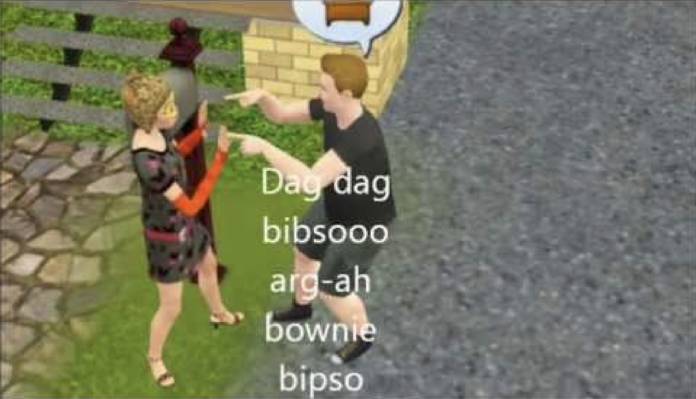Lass frooby noo, Yarby dansel dable doops, Imi dooka mimi shoops!
Everyone knows “The Sims.” Whether you spend your time designing the perfect house or seeing how many Sims you can fit in a single shallow pool, the game provides hundreds of hours of air-headed fun. Fans know it wouldn’t be the same without its fictional gibberish language. Simlish, which is often described as what English sounds like to non-English speakers, is the official language of the game and its many spin-offs and sequels.
The language originated as just a few simple repeated phrases. Creator Will Wright knew dialogue was integral to the experience and decided to improve the audio. In an interview with Great Big Story, “The Sims” 1 & 2 audio director Claire Curtin explained that originally, the team considered using Navajo, Ukranian or Estionian as the base of Simlish. Rather than be held down by conventions, they opted for a structureless, improvisation-based sound. Most of the time, it sounds like jumbled English with a few similarities. Popular Simlish phrases that any dedicated “Sims” player will instantly understand vary from “Yebs” and “Neeb” (yes and no) to “Ravasheen!” (“Ooh, I look like a smokin’ hottie in this!”).
The task of making Simlish equally believable and not-understandable lies on the shoulders of talented voice actors. Videos of Simlish recording sessions are jarring to watch. It is mostly just two people in a room shouting convincing nonsense into a mic with boundless enthusiasm. Realizing how much of an impact the language had in “The Sims 1,” Electronic Arts games decided to put more effort into the auditory experience of playing.
In “The Sims 2,” the inclusion of music is apparent. Originally, when your Sim interacted with a radio or music player, you would get stock music to fit different moods. They later expanded this by getting popular recording artists to come in and re-record their songs in the fictional language.
The list of musicians whose work appears in the games is incredibly long and even more varied. They are recorded with intention to fit various moods and genres, so they recruited many different artists. Some of the most notable being Aly and AJ, the Pussycat Dolls, The Veronicas, Neon Trees, Soulja Boy, My Chemical Romance, Luke Bryan, Paramore and 3OH!3. According to “Sims 2” audio director Robi Kauker, the artists love re-recording their songs. In an interview with cnet.com he said, “You’d be surprised how much the singers like it.”
Because of the way Simlish is set up, the songs are prepared for the artists rather than improvised. The language does not use an exact structure, but words do repeat. For example, Carly Rae Jepsen’s hit pop jam “Run Away With Me” chorus’ sounds like “nao eh tay son day/nao eh tay son day” everytime it is sung.
“The Sims” discography is close to flawless. Of their long list of timeless hits, one name undoubtedly sits atop: T.G.I.F by Katy Perry, arguably the most famous song recorded in Simlish (and whose lyrics are featured in the headline). This collaboration was so warmly welcomed it inspired an entire Perry themed expansion pack and recordings of her other songs in Simlish.
Many songs are accompanied by their own Sim music video. Lily Allen’s smash hit “Smile” is one of these. Same with “Need You Now” by Lady A, which retained its swooning vulnerability through the translation process. Though the lyrics are unintelligible, the flow of the song remains.
Sadly, neeb, Simlish songs are not available on streaming services. But most are on Youtube and they normally have really great comments sections so I would recommend checking those out. Who knew “The Sims” community was a bunch of comedians? Simlish songs are incredibly odd, but retain the flow and charm of the music we know and love. They once again prove that language isn’t a barrier when it comes to great music.
Written by: Livvy Mullen — arts@theaggie.org






